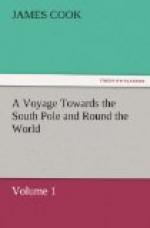On the 24th, the wind blew from N.W. to N.E., a gentle gale, fair and cloudy. At noon we were by observation, in the latitude of 56 deg. 31’ S, and longitude 31 deg. 19’ E., the thermometer at 35. And being near an island of ice, which was about fifty feet high, and 400 fathoms in circuit, I sent the master in the jolly-boat to see if any water run from it. He soon returned with an account that there was not one drop, or any other appearance of thaw. In the evening we sailed through several floats, or fields of loose ice, lying in the direction of S.E. and N.W.; at the same time we had continually several islands of the same composition in sight.
On the 25th, the wind veering round from the N.E., by the east to south, it blew a gentle gale; with which we stood to the W.S.W, and at noon were in the latitude of 57 deg. 50’ S., and longitude 29 deg. 32’ E. The weather was fair and cloudy; the air sharp and cold, attended with a hard frost. And, although this was the middle of summer with us, I much question if the day was colder in any part of England. The wind continued at south, blew a fresh gale, fair and cloudy weather, till near noon the next day, when we had clear sun-shine, and found ourselves, by observation, in the latitude of 58 deg. 31’ S., longitude 26 deg. 57’ E.
In the course of the last twenty-four hours we passed through several fields of broken loose ice. They were in general narrow, but of a considerable length, in the direction of N.W. and S.E. The ice was so close in one, that it would hardly admit the ship through it. The pieces were flat, from four to six or eight inches thick, and appeared of that sort of ice which is generally formed in bays or rivers. Others again were different; the pieces forming various honey-combed branches, exactly like coral rocks, and exhibiting such a variety of figures as can hardly be conceived.
We supposed this ice to have broke from the main field we had lately left; and which I was determined to get to the south of, or behind, if possible, in order to satisfy myself whether or not it joined to any land, as had been conjectured. With this view I kept on to the westward, with a gentle gale at south, and S.S.W., and soon after six o’clock in the evening, we saw some penguins, which occasioned us to sound; but we found no ground with 150 fathoms.
In the morning of the 27th, we saw more loose ice, but not many islands; and those we did see were but small. The day being calm and pleasant, and the sea smooth, we hoisted out a boat, from which Mr Forster shot a penguin and some peterels. These penguins differ not from those seen in other parts of the world, except in some minute particulars distinguishable only by naturalists. Some of the peterels were of the blue sort, but differed from those before-mentioned, in not having a broad bill; and the ends of their tail feathers were tipped with white instead of dark-blue. But whether these were only the distinctions betwixt the male and female, was a matter disputed by our naturalists. We were now in the latitude of 58 deg. 19’ S., longitude 24 deg. 39’ E., and took the opportunity of the calm, to sound; but found no ground with a line of 220 fathoms. The calm continued till six in the evening, when it was succeeded by a light breeze from the east, which afterwards increased to a fresh gale.




